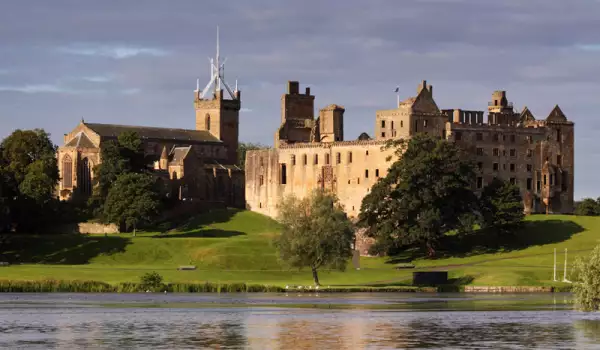Linlithgow Palace

Linlithgow Palace is magnificently situated in the center of the town of Linlithgow in Scotland, which is only 15 miles west of Edinburgh. Although surrounded by ruins the roof top was the majority of remaining structures of Castle Linlithgow but today it still emits an aura of a great former military fort. Linlithgow Palace is situated on a low hilly area next to a beautiful lake, which arouses the interest of many ornithologists as there are many interesting species of birds that inhabit there.
Linlithgow Palace is now part of the cultural heritage of Historic Scotland. This southeastern part of the country is constantly filled with visitors who go there to see the ruins of the castle or just to have a picnic on the lawn in front of it. The possibility of a leisurely stroll along the lake is also no less attractive.
From 1st April to 30th September Linlithgow Palace is open for public visits from 9:30 am to 5:30 pm and from 1st October to 31st March the ruins can be entered from 9:30 am – 4:30 pm.
It is believed that the area of Linlithgow Palace was settled 2000 years ago as the Roman presence there had left their footprints. Prince David I (1124-1153) was the first monarch who decided to build a royal residence at the site of today's Linlithgow Palace.

Around its fortification the people began to gradually form a small city. In the 14th Century King Edward I decided to erect on the foundations of this new fortress and it was constructed entirely of a stone military structure. The newly built Linlithgow Palace became a convenient military base because of its strategic location.
The main function of the Linlithgow Palace was to provide different routes for deliveries between Edinburgh Castle and Stirling Castle.
In 1424 the town and fortress of Linlithgow Palace were partially destroyed in the conflagration. King James I undertook the restoration of the palace in order to turn it into a royal residence.
Restoration work began in the Church of St Michael, located south of the palace. This church is an integral part of the history of the Linlithgow Palace. It remains forever marked by the reign of the powerful family of Stuart as the queen very much liked the tranquility and fresh air in the Linlithgow Palace.
In the 16th century in the huge and magnificent Linlithgow Palace residents included, King James V, Mary Queen of Scots and Princess Elizabeth, also known as, Ice Queen. In 1745 a huge fire caused irreversible damage to the Linlithgow Palace.















